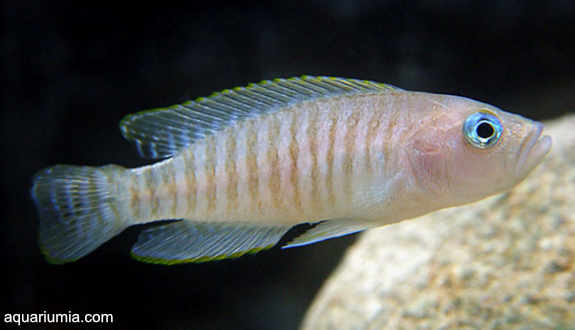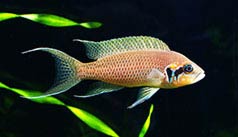

Alternative species (click on the thumbnail to see the card)
Names
Scientific name
Neolamprologus multifasciatus
Lamprologus multifasciatus
Common name
Many Banded Shell-Dweller
Multifasciatus Dwarf Cichlid
Multi
Multies
Schneckenbuntbarsch (DE)
Origin

Origin: South of Lake Tanganyika
Biotope: African
Dimorphism

Adult males are larger than females.
Group

Cichlidae
Volume

100 L / 22 imp gal / 26 US gal
Parameters

T°: 22 to 26°C or 72 to 79°F
pH: 8.2 to 9.5
Hardness: 15 to 20°dGH
Difficulty

Easy
Size

3 to 4cm (1.2 to 1.6")
Longevity

5 years
Living zone

Depth
Individuals

6
Food
How to feed the Neolamprologus multifasciatus?
Food
How to feed the Neolamprologus multifasciatus?
The Multi is a carnivorous fish. In the wild, it feeds mainly on zooplankton. In captivity, it will accept whatever you offer it and it will be adapted to the size of its mouth. Its preferences go towards small live or frozen prey such as daphnia, artemia or cyclops. Spinach and cucumber will also be appreciated at their true value.
Behavior
What kind of behavior does the Neolamprologus multifasciatus have?
Behavior
What kind of behavior does the Neolamprologus multifasciatus have?
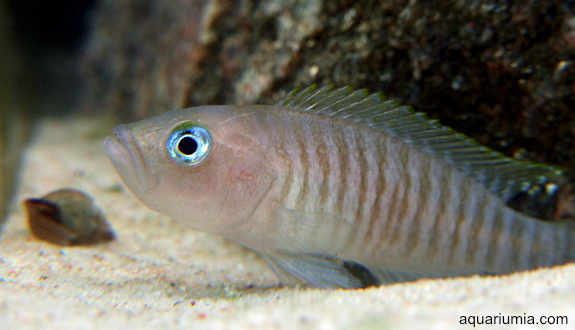
It is a sedentary fish, that is to say that it never moves away from the shell that serves as its refuge. It spends a lot of time shaping its environment, especially moving sand around its shell. Moreover, attention works! Indeed, these fish dig so much that it is not rare to find the bottom glass of the aquarium bare, the sand forming 15 cm mounds of sand against the side windows. This is why fix the elements of the decor well so that they do not destabilize and avoid accidents. To do this, when installing the aquarium, glue the rocks or roots together and wedge them on the bottom glass (not on the sand) before putting your sand in.
Small does not mean without character! This small fish has a very strong character and does not hesitate to scare much bigger fish away from its territory (they can even band together)! However, be reassured, it is only rarely aggressive and does not pose any particular cohabitation problem.
Note that the males of the colony, when they are numerous, come out at dusk to meet each other. There they observe and judge each other before leaving on their territory. Amusing these small meetings!
Cohabitation
Who can live with the Neolamprologus multifasciatus?
Cohabitation
Who can live with the Neolamprologus multifasciatus?
Very gregarious, this species needs to live in colonies. As they don't move around a lot, you can keep a group of 6 fish in a rather small volume (100 L / 22 Imp gal / 26 US gal will be enough). A hierarchy will be established (bickering and parades will be on the program) and the fish will form either couples or harems. Therefore, choose preferably one male for two females and install two or three groups of this type in your aquarium according to the available floor space.
To better enjoy their fascinating behaviour, we advise you to maintain this species in a specific aquarium.
Breeding
How to breed the Neolamprologus multifasciatus?
Breeding
How to breed the Neolamprologus multifasciatus?
The reproduction of this species is very easy since it does not require the intervention of the aquarist. It is quite discreet and not very prolific. Finally... there are few fry per laying (between 5 and 15), but they are very regular! Thus, in good conditions, you can hope to see your group growing quickly. It will then be necessary to separate you regularly from a part of the young so as not to find yourself in overpopulation.
The ideal temperature for reproduction is 23°C or 73°F. The laying is deposited in an eggshell. The female takes care of the eggs and the male takes care of the surveillance of the territory.
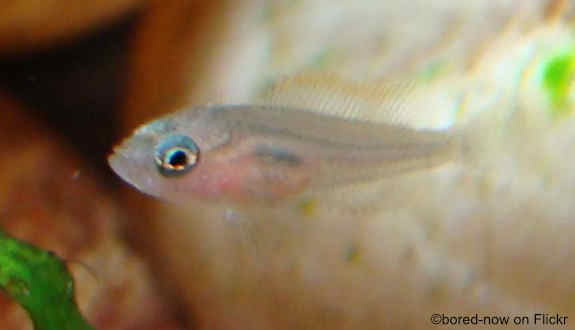
At hatching, the young fish measure only 5 mm and will grow only slowly. They do not yet possess the vertical bands that will only appear when the fish are mature (at the age of 8-10 months). They do not leave their shell but the parents do not take care of them.
Fry feeding: artemia nauplias, micro worms and fry powders.
Its aquarium
Which aquarium for the Neolamprologus multifasciatus?
Its aquarium
Which aquarium for the Neolamprologus multifasciatus?
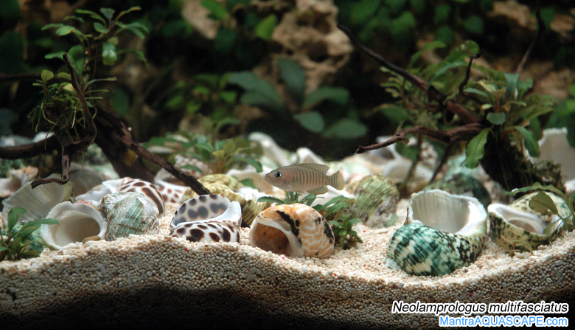
In nature, it lives in areas rich in empty snail shells (shellfish). In captivity, it is not an option: it is absolutely necessary to offer him a soil of fine sand type Loire sand of a good thickness. Have a lot of empty shells and make several layers of them because they like the stacking of shells very much (it creates mazes and corridors of circulation). For the choice of shells, you can ideally use shells of Neothauma tanganyicense (snails from Lake Tanganyika). Otherwise, the shells of burgundy snails or whelks also work.
It is imperative to offer them a good filtration in order to guarantee a beautiful oxygenation of the water. It will also be necessary to take care of its cleanliness by changing 1/4 of the volume every week. If your pH is not high enough, use a bubbler.
Note that plants are often uprooted by this small digger. Indeed, in spite of its small size, what does it carry like sand! You will undoubtedly be surprised by the intensity of this activity (it seems that in the event of important piling up of shells, this behavior is attenuated). You will thus have to fix your plants to other elements of the decoration like rocks or roots. Choose Anubias or Microsorium for example. However, note that it is not imperative to have plants in an aquarium for the Neolamprologus multifasciatus.
Good To know
Find all additional information!
Good To know
Find all additional information!
It is the smallest cichlid in the world! Indeed, the largest males will painfully reach 5 cm or 2".
Robust, interesting and not posing any particular maintenance problem, it is the perfect fish to start in aquarium!
Its name "multifasciatus" means "full of stripes".
Yours photos!
Comments
Sort by:
Please login to post comments
